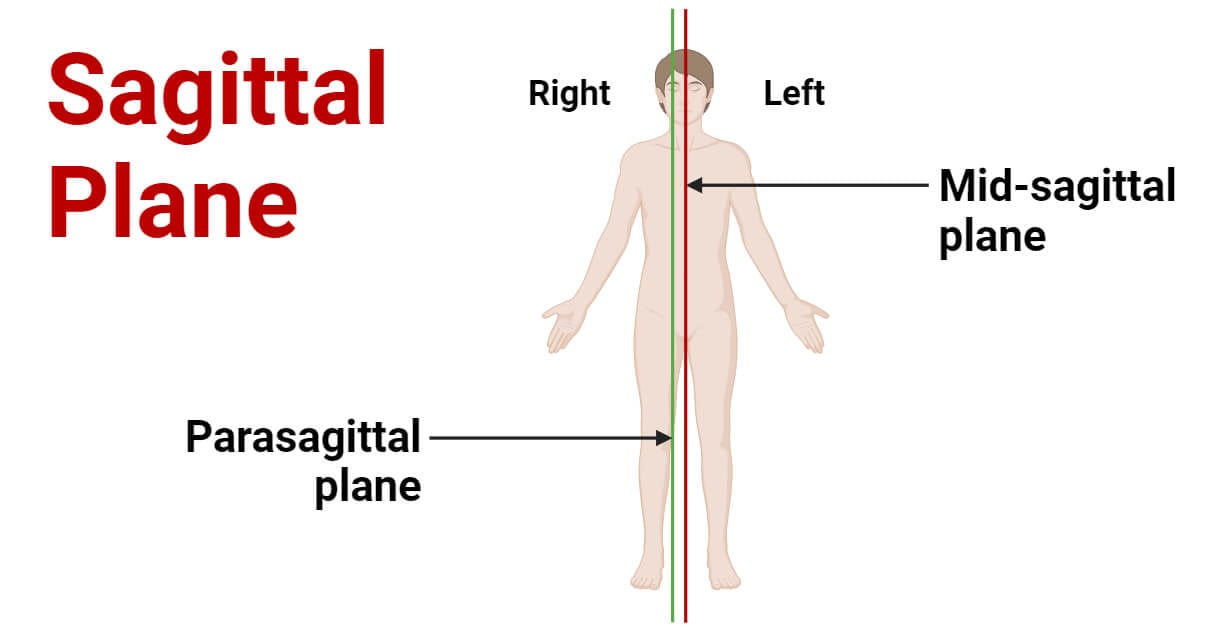The movement of our body occurs in three different anatomical planes of motion: coronal, sagittal, and transverse.
The three planes of the body can be briefly discussed below:
Coronal (frontal or Y-X) plane: it is the imaginary vertical plane in the body dividing the body into ventral (anterior/front) and back dorsal (posterior/back) halves (also called belly and back sections). It is responsible for side-to-side movements.
Transverse (axial or X-Z) plane: it is any imaginary horizontal plane parallel to the ground passing through the center of the body, separating the body into cranial (superior/upper/top) and caudal (inferior/lower/bottom) parts. It usually runs almost perpendicular to the spine. It is responsible for twisting movements in the body.
Sagittal (longitudinal) plane: It is a vertical imaginary plane parallel to the median plane that divides the body into sinister (left) and dexter (right) sides. It is responsible for forward and backward movements.

Interesting Science Videos
What is the Sagittal Plane?
The term “sagittal” originates from the Latin word “sagitta”, meaning “arrow” and was coined by Grerad of Cremona. The name was possibly derived from the arrow-like trajectory of an arrow piercing the body or the notching of the sagittal suture.
The Sagittal Plane is an imaginary longitudinal plane dividing the body into right and left halves. It is perpendicular to transverse and coronal planes.
A vertical plane passes through the body longitudinally, responsible for forward and backward movements.

The sagittal plane itself can be further divided into specific regions such as:
- Mid-sagittal plane
- Parasagittal plane
- Specific sagittal plane, midsagittal or median plane located in the midline divides the body into equal halves, passing through midline structures like the navel or spine. When combined with the umbilical plane, the midsagittal plane distinguishes the four quadrants of the abdomen in the human body.
- Other sagittal planes, called parasagittal planes, run parallel to the midsagittal plane and divide the body into unequal parts.
- The parasagittal planes include the midclavicular line and lateral sternal and parasternal planes.
- Movements within the sagittal plane include flexion, extension, hyperextension, dorsiflexion, and planar flexion, responsible for walking, running, squatting, and lifting weights.
- It is fundamental in workout routines or exercises, such as squats, deadlifts, and bench presses which involve movements within this plane.
Movements in the sagittal (longitudinal) plane
- Flexion: It involves bending a limb to reduce the angle at the joint, demonstrated when lifting a dumbbell during a bicep curl to flex the elbow.
- Extension: It refers to a movement that enlarges the angle at a joint, such as lifting the leg behind you while standing, which extends the pelvic joint
- Dorsiflexion: It is the movement of bending the ankle in a manner that brings the top of the foot closer to the shin
- Plantar flexion: It involves bending the ankle, so the foot presses downward, causing the toes to point away.
- Extension: movement that increases the angle at a joint (e.g., lifting your leg behind you when standing extends the hip joint)
Axis of Movements
Sagittal axis: The sagittal axis is perpendicular to the sagittal plane lying in the coronal plane. It is associated with movements such as abduction (moving the limb away from the midline, such as raising the arms) and adduction (the movements of limbs towards the body’s midline, like lowering the arms), which occur relative to the coronal plane. Splaying fingers apart is the abduction movement whereas bringing fingers back together is adduction.
Coronal(frontal) axis: The coronal axis is perpendicular to the coronal plane and resides within the sagittal plane. It is involved in movements like extension and flexion, occurring within the sagittal plane. Extension happens when the angle between adjacent body segments widens with their ventral part moving apart, typically within a sagittal plane around a frontal axis. However, the thumb’s extension deviates from this pattern, occurring in a frontal plane around a sagittal axis.
Flexion, conversely, involves the narrowing of the angle between adjacent body segments, bringing their ventral surface closer together. This movement usually occurs within the sagittal plane around the frontal axis.
In a broader anatomical context, the coronal plane, along with reference planes such as sagittal planes and transverse planes, aids in describing the spatial relationships between body parts like the degree of prognathism.
Significances/Applications of Sagittal Plane
- Anatomy and medicine: Body planes have several uses within the anatomy field, including in medical imaging techniques such as MRI, CT scan, and X-rays allowing for accurate diagnosis.
- Kinesiology: The sagittal plane is fundamental for analyzing human movement patterns. It helps in understanding sports biomechanics, exercises, etc.
- Therapy: The therapist utilizes the knowledge of the sagittal plane to customize treatment programs to specific injuries or movement dysfunction.
- Training: Athletes utilize the understanding of the sagittal plane to optimize performance in sports, to enhance the strength, and agility within this plane reducing the risk of injuries.
Overall, the understanding of the sagittal plane enhances our ability to analyze and address various aspects of human health, performance, and well-being.
References
- Anatomical terminology. National Cancer Institute SEER Training Modules. Retrieved from https://training.seer.cancer.gov/anatomy/body/terminology.html
- Cardinal Planes and Axes of Movement. Physiopedia. Retrieved from https://www.physio-pedia.com/Cardinal_Planes_and_Axes_of_Movement
- Davidson, K. (2023). A guide to body planes and their movements. Healthline. Retrieved from https://www.healthline.com/health/body-planes#sagittal-plane
- Gibson, C.M. Sagittal Plane. WikiDoc. Retrieved from https://www.wikidoc.org/index.php/Sagittal_plane
- https://med.libretexts.org/Bookshelves/Anatomy_and_Physiology/Anatomy_and_Physiology_(Boundless)/1%3A_Introduction_to_Anatomy_and_Physiology/1.4%3A_Mapping_the_Body/1.4D%3A_Body_Planes_and_Sections
- Hurst, J. (2011). Anatomy and Physiology in a Flash. F.A. Davis Company. Retrieved from https://books.google.com.np/books?id=YWz2AAAAQBAJ&pg=PA10&lpg=PA10&dq=sagittal+plane&source=bl&ots=fJjivs_wNJ&sig=ACfU3U3OBe2SLWEayXgDqOE9YN74F8ZDRQ&hl=en&sa=X&ved=2ahUKEwjNqY2xy_WFAxUEM1kFHXMhCO84KBDoAXoECAIQAw#v=onepage&q=sagittal%20plane&f=false
- Jones, O. (2022). Anatomical Planes. Teach Me Anatomy. Retrieved from https://teachmeanatomy.info/the-basics/anatomical-terminology/planes/
- Planes of motion: Sagittal, Frontal, Transverse. Physique Development. Retrieved from https://physiquedevelopment.com/planes-of-motion-sagittal-frontal-transverse/
- Understanding the Sagittal Plane(2021). Wellness. Retrieved from https://www.masterclass.com/articles/sagittal-plane-explained
